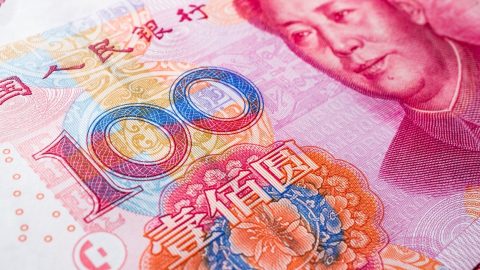On 11 August China devalued its currency by 1.9% relative to the US Dollar and announced that in the future it would expose the exchange rate of the Renminbi to the forces of supply and demand on the foreign exchange market. In a press conference the Central Bank did say, however, that it would continue to intervene if the development of the Chinese currency were “volatile”, “irrational”, or “distorted”.
More flexible exchange rate regime
From a technical point of view, the exchange rate regime has changed only marginally. The official pegging of the Chinese currency to the US Dollar was suspended in 2005, and a so-called managed exchange rate system was introduced. Since then, the exchange rate has been set daily on the basis of a currency basket (consisting of the US Dollar, the Japanese Yen, the British Pound, and the Korean Won). Over the years the daily bandwidth of the Yuan has been gradually expanded relative to the US Dollar to recently plus/minus one percent. Nowadays the Central Bank compiles quotations from large banks that are based on the closing rate of the previous trading day in order to set the daily rate. In doing so the Central Bank reserves the right to continue intervening if the fluctuations are excessive. Since Monday the Renminbi has fallen by 3% vis-à-vis the US dollar.
Transformation into a market economy
The measures represent a further important step towards a fully flexible exchange rate mechanism. This is part of the long-term transformation process of China, which contains a gradual shift from a planned economy to a market economy. The process will involve, among other things, the liberalisation of the financial system and the internationalisation of the currency.
Reserve currency Renminbi
China’s policy is also geared towards the Chinese currency achieving the status of an official reserve currency. A fully flexible currency is the basic condition for being taken into the currency basket of the IMF for special drawing rights. The decision about this issue will be taken in autumn. A reserve currency should be stable in the long run in order to fulfil the value storage function of money. But it makes no sense to peg one reserve currency to another one.
Weakening economic growth
Chinese economic growth has been on a noticeable decline. The Chinese government is trying to stabilise this trend. Only last week it initiated a stimulus programme to the tune of 1.5% of GDP. Generally speaking, further supporting measures from the political front would fit the picture in this environment.
Robust currency
Since the beginning of 2005, the Renminbi has appreciated by about 50% relative to the currency basket mentioned above. It is also one of the few currencies that have joined the US Dollar on its way up since July 2014. This means that the Renminbi is one of the most robust currencies in the world. But with the increasing deterioration of the fundamental environment, the depreciation pressure has increased as well. The Chinese Central Bank, however, has issued the assurance that it is not interested in a prolonged depreciation of the currency and that the exchange rate was in line with the fundamental environment.
Emancipation from the US Fed
In view of the imminent start of the cautious interest rate hikes in the USA the Chinese Central Bank is emancipating itself from its US peer. A higher Fed funds rate in the USA has increased the pressure in China for rate hikes in order to maintain the exchange rate stable.
Pressure on Asian currencies
The pressure on other central banks, especially in the emerging markets in Asia, to cut the key-lending rates and/or devalue the currency will increase.
Adjustment in the emerging markets
The devaluation confirms the current environment in many emerging markets: falling export prices for goods, falling currencies, falling equity prices. This is due to a high, and drastically increased, level of debt in the private sector in many countries. At the same time both profitability and productivity have fallen. Adjustment is the consequence.
Goods from Asia become cheaper
As a result of the depreciation of the Chinese currency the pressure for prices to fall is being exported. Goods from Asia are becoming cheaper. This decreases the already low risk of inflation even further.
Overall we are taking a positive stance on the devaluation of the Chinese currency. The risk of a recession and deflation in China declines, and the structural reforms in China are making progress. But the step is also another sign of the fact that the boom in the emerging markets has made way for the adjustment to a changed environment. This also spills over into the developed economies: exports to the emerging markets are negatively affected, while imports are becoming cheaper.
Legal disclaimer
This document is an advertisement. Unless indicated otherwise, source: Erste Asset Management GmbH. The language of communication of the sales offices is German and the languages of communication of the Management Company also include English.
The prospectus for UCITS funds (including any amendments) is prepared and published in accordance with the provisions of the InvFG 2011 as amended. Information for Investors pursuant to § 21 AIFMG is prepared for the alternative investment funds (AIF) administered by Erste Asset Management GmbH pursuant to the provisions of the AIFMG in conjunction with the InvFG 2011.
The currently valid versions of the prospectus, the Information for Investors pursuant to § 21 AIFMG, and the key information document can be found on the website www.erste-am.com under “Mandatory publications” and can be obtained free of charge by interested investors at the offices of the Management Company and at the offices of the depositary bank. The exact date of the most recent publication of the prospectus, the languages in which the fund prospectus or the Information for Investors pursuant to Art 21 AIFMG and the key information document are available, and any other locations where the documents can be obtained are indicated on the website www.erste-am.com. A summary of the investor rights is available in German and English on the website www.erste-am.com/investor-rights and can also be obtained from the Management Company.
The Management Company can decide to suspend the provisions it has taken for the sale of unit certificates in other countries in accordance with the regulatory requirements.
Note: You are about to purchase a product that may be difficult to understand. We recommend that you read the indicated fund documents before making an investment decision. In addition to the locations listed above, you can obtain these documents free of charge at the offices of the referring Sparkassen bank and the offices of Erste Bank der oesterreichischen Sparkassen AG. You can also access these documents electronically at www.erste-am.com.
Our analyses and conclusions are general in nature and do not take into account the individual characteristics of our investors in terms of earnings, taxation, experience and knowledge, investment objective, financial position, capacity for loss, and risk tolerance. Past performance is not a reliable indicator of the future performance of a fund.
Please note: Investments in securities entail risks in addition to the opportunities presented here. The value of units and their earnings can rise and fall. Changes in exchange rates can also have a positive or negative effect on the value of an investment. For this reason, you may receive less than your originally invested amount when you redeem your units. Persons who are interested in purchasing units in investment funds are advised to read the current fund prospectus(es) and the Information for Investors pursuant to § 21 AIFMG, especially the risk notices they contain, before making an investment decision. If the fund currency is different than the investor’s home currency, changes in the relevant exchange rate can positively or negatively influence the value of the investment and the amount of the costs associated with the fund in the home currency.
We are not permitted to directly or indirectly offer, sell, transfer, or deliver this financial product to natural or legal persons whose place of residence or domicile is located in a country where this is legally prohibited. In this case, we may not provide any product information, either.
Please consult the corresponding information in the fund prospectus and the Information for Investors pursuant to § 21 AIFMG for restrictions on the sale of the fund to American or Russian citizens.
It is expressly noted that this communication does not provide any investment recommendations, but only expresses our current market assessment. Thus, this communication is not a substitute for investment advice.
This document does not represent a sales activity of the Management Company and therefore may not be construed as an offer for the purchase or sale of financial or investment instruments.
Erste Asset Management GmbH is affiliated with the Erste Bank and austrian Sparkassen banks.
Please also read the “Information about us and our securities services” published by your bank.

